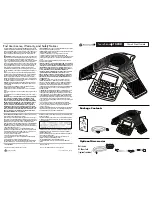
Glossary
A31003-W1040-U101-1-7619, July 2006 DRAFT
272
HiPath Wireless Controller, Access Points and Convergence Software V4.0, C10/C100/C1000 User Guide
hwc_glossary.fm
Networking terms and abbreviations
Fit, thin and fat APs
A thin AP architecture uses two components: an access point that is
essentially a stripped-down radio and a centralized management
controller that handles the other WLAN system functions. Wired
network switches are also required.
A fit AP, a variation of the thin AP, handles the RF and encryption, while
the central management controller, aware of the wireless users'
identities and locations, handles secure roaming, quality of service,
and user authentication. The central management controller also
handles AP configuration and management.
A fat (or thick) AP architecture concentrates all the WLAN intelligence
in the access point. The AP handles the radio frequency (RF)
communication, as well as authenticating users, encrypting
communications, secure roaming, WLAN management, and in some
cases, network routing.
FQDN
Fully Qualified Domain Name. A "friendly" designation of a computer,
of the general form computer.[subnetwork.].organization.domain. The
FQDN names must be translated into an IP address in order for the
resource to be found on a network, usually performed by a Domain
Name Server.
FTM
Forwarding Table Manager
FTP
File Transfer Protocol
Gateway In
the
wireless
world, an access point with additional software
capabilities such as providing NAT and DHCP. Gateways may also
provide VPN support, roaming, firewalls, various levels of security, etc.
Gigabit Ethernet
The high data rate of the Ethernet standard, supporting data rates of
1 gigabit (1,000 megabits) per second.
GUI
Graphical User Interface
Heartbeat message
A heartbeat message is a UDP data packet used to monitor a data
connection, polling to see if the connection is still alive.
In general terms, a heartbeat is a signal emitted at regular intervals by
software to demonstrate that it is still alive. In networking, a heartbeat
is the signal emitted by a Level 2 Ethernet transceiver at the end of
every packet to show that the collision-detection circuit is still
connected.
Term
Explanation
Table 19
Summary of Contents for HiPath C10
Page 299: ......
















































